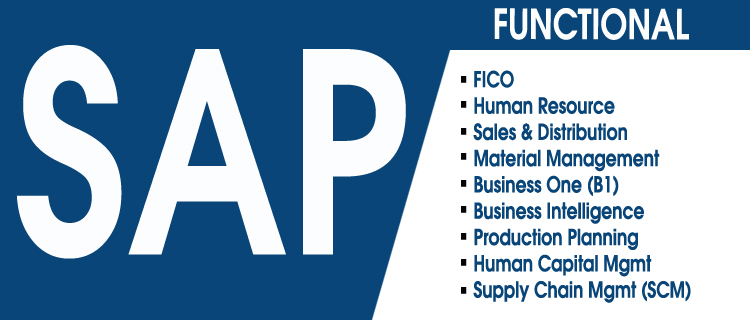SAP TRAINING COURSES
Contact relevant Texas School of Continuing Education & Recruitment branch / Email info@tscer.org
12808 W. Airport Suite 300 Sugarland TX 77478 - CALL : 832-240-1786
4203 Woodcock Drive Suite 209 San Antonio TX, 78228 – CALL : 210-871-0678
13140 COIT ROAD, SUITE 370, DALLAS, TX 75240 – CALL : 972-687-7746

FUNCTIONAL MODULES IN SAP
Financial Modules for Sap Training: Financial Accounting (FI), Controlling (CO), Investment Management (IM), Treasury (TR), Enterprise Control (EC).
Logistics Modules: Material management (MM), Sales & distribution (SD), Production, Planning & Control (PP), Product Data Management (PDM), Quality Management (QM), Plant maintenance (PM), Service management(SM), Project systems (PS) sap training


Human resource management Module: Personnel Management, Organizational Management, Payroll Accounting, Time Management, Personnel Development, Training & Event Management
Cross Application Module: Workflow (WF), SAP Office.
Technical components
SAP Basis
SAP BC – BASIS Components :
Identify the no of users and type of users
Design the technical system landscape of servers
Do the sizing based on users, documents created.
Convert your sizing requirement into Hardware requirements
Consider the backup procedure also
Then start with the set-up of the development landscape
Define client strategy, transport strategy, User management.
Fix the support package levels.
Tune the system for performance
set up the QA systems sap training
Define client copy strategy
Set-up the PROD systems
Apply for Pre Go live report
Monitor system of DB load
Apply post go-live report
ABAP
ABAP – Advanced Business Application Programming
NetWeaver “Business Process Management” apps
SAP KMC – Knowledge Management & Collaboration
SAP DMS – Document Management Service
SAP CMS – Content Management Service
SAP XI – Exchange Infrastructure
SAP PI – Process Integration
SAP EP – Enterprise Portal
SAP BW- Business Warehouse
SAP BIW – Business Intelligence & Data Warehousing
IS (Information Systems) Management
SAP CCMS – Computing Center Mgmt System
SAP MDM – Master Data Management
SAP BC-CCM-ADK – Archiving Development Kit
SAP CCM-API – Application Program Interfaces
SAP CCM-BTC – Background Processing
SAP CCM-CNF – Configuration
SAP CCM-HAV – High Availability
SAP CCM-MON – Monitoring
SAP CCM-PRN – Print and Output Management
SAP MDM100 – Master Data Management
SAP MDM101 – MDM GDSSAP MDM300 – MDM Print Publishing
SAP MDM400 – MDM Data Modeling
SAP Business Suite Definition:
SAP Business Suite is a collection of various SAP enterprise software that ensure optimized execution of business strategies. It consists of the following SAP Systems:
1.SAP Customer Relationship Management (SAP CRM)
2.SAP Enterprise Resource Planning (SAP ERP)
3.SAP Product Lifecycle Management (SAP PLM)
4.SAP Supply Chain Management (SAP SCM)
5.SAP Supplier Relationship Management (SAP SRM).
SAP CRM (Customer Relationship Management)
SAP CRM supports all customer related processes and activities like sales and services. It enables the collaboration between the in-house employees, field employees, partners, and customers. SAP CRM supports various types of interaction channels like internet, Mobile Phones etc to communicate with customers directly.
SAP ERP (Enterprise Resource and Planning)
The application lets your people work more quickly and cost-effectively – connecting them directly to business processes and delivering the information and capabilities they need to make decisions and take action. It also enables you to innovate and adapt to the changing requirements of your industry – at lower cost and with greater speed.
SAP ERP- SEM (Strategic Enterprise Management Software) :: SAP Strategic Enterprise Management (SAP SEM) delivers end-to-end ERP software capabilities to support the entire performance management lifecycle, including Consolidated Financial Reporting, Planning, budgeting & forecasting, Corporate performance management and scorecards & Risk Management

SUB Modules:
SEM-BCS – Business Consolidation
SEM-BIC – Business Information Collection
BW-BPS – Business Planning and Simulation
SEM-CPM – Corporate Performance Monitor
SEM-SRM – Stakeholder Relationship Management
SAP PLM (Product Life Cycle Management) :
Product Lifecycle Management is a collection of solutions that can be used to digitally create and maintain product information to be made available to the entire organization at any point in time.
It provides all needed information about the complete product and asset lifecycle through the extended supply chain, sap training thereby ensuring legal compliance.
SUB Modules
SAP PLM_RM – Recipe Management
SAP PLM_AM – Audit Management
SAP PLM400 – Quality Management
SAP PLM410 – Quality Notifications
SAP PLM405 – Quality Inspections
SAP PLM425 – QM in Sales and Distribution
SAP SCM (SAP Supply Chain Management)
SAP Supply Chain Management (SAP SCM)
enables collaboration, planning, execution, and coordination of the entire supply network, empowering you to adapt your supply chain processes to an ever-changing competitive environment.
SAP – APO – SAP Advance Planning and Optimization
SAP – OCH – SAP Inventory Collaboration Hub
SAP – EM – SAP Event Management
SAP SRM (Supply Relationship Management)::
Supplier Relationship Management (SRM) enables the full range of supply and procurement activities from the strategy stage to execution
SUB Modules:
SEM-BCS – Business Consolidation
SEM-BIC – Business Information Collection
BW-BPS – Business Planning and Simulation
SEM-CPM – Corporate Performance Monitor
SEM-SRM – Stakeholder Relationship Management
SAP PLM (Product Life Cycle Management) :
- Product Lifecycle Management is a collection of solutions that can be used to digitally create and maintain product information to be made available to the entire organization at any point in time.
- It provides all needed information about the complete product and asset lifecycle through the extended supply chain, sap training thereby ensuring legal compliance.
SUB Modules
SAP PLM_RM – Recipe Management
SAP PLM_AM – Audit Management
SAP PLM400 – Quality Management
SAP PLM410 – Quality Notifications
SAP PLM405 – Quality Inspections
SAP PLM425 – QM in Sales and Distribution
SAP SCM (SAP Supply Chain Management)
SAP Supply Chain Management (SAP SCM) enables collaboration, planning, execution, and coordination of the entire supply network, empowering you to adapt your supply chain processes to an ever-changing competitive environment.
SAP – APO – SAP Advance Planning and Optimization
SAP – OCH – SAP Inventory Collaboration Hub
SAP – EM – SAP Event Management
SAP SRM (Supply Relationship Management)::
Supplier Relationship Management (SRM) enables the full range of supply and procurement activities from the strategy stage to execution
Functional Modules
SAP FI – Financial Accounting::
Designed for automated management and external reporting of General Ledger (GL), Accounts Receivable (AR), Accounts Payable (AP), and Asset Management (AM) with a user-defined chart of accounts.
External reporting, such as income statement and balance sheet represents cost and revenue flows throughout the organization
Aids in organizational decision making
Supports internal reporting such as cost center reports
SUB Modules
SAP FI-GL – General Ledger
SAP FI-AP – Accounts Payable
SAP FI-AR – Account Receivable
SAP FI-SL- Special Purpose Ledger
SAP FI-BL – Bank Accounting
SAP AA – Asset Accounting: AA provides tools to acquire, depreciate, evaluate, and retire assets. The kinds of assets covered are fixed, low value, leased, and real estate.
Low-value assets depreciate in the year they are bought and are often aggregated as a single asset master record.
Depreciation often needs to be tracked (for more than one reason), so SAP R/3allows you to depreciate the same piece of equipment in several parallel ways.
SAP CO – Controlling:: SAP CO Module helps management by providing reports on cost centers, profit centers, contribution margins, profitability, etc. They also deal with cost accounting processing, analytical reporting, and audit-controlling spectrums.
SUB Modules
SAP CO-CEA – Cost Element Accounting
SAP CO-CCA – Cost Center Accounting
SAP CO- Internal Orders
SAP CO- Activity-Based Costing
SAP CO-PC- Product Cost Controlling
SAP CO-PA- Profitability Analysis
SAP CO-PCA- Profit Center Accounting
SAP CO-OM- Overhead Cost controlling
SAP CO-ML- Material Ledger
SAP TR – Treasury
SUB Modules
SAP TR-CB – Cash Budget Management
SAP TR-MRM – Market Risk Management
SAP TR-CM – Cash Management
SAP TR-LO – Loans Management
SAP TR-TM – Treasury Management
SAP TR-FM – Funds Management
SAP IM – capital Investment Management :: It used for planning, budgeting and monitoring of a comprehensive budget .An investment program represents the planned or budgeted costs for the capital investments of an enterprise. Using investment programs, you can obtain an overview of planning and budgeting processes in complex enterprise structures for all investments and large projects of the group, while at the same time maintaining strict budgetary control.
Human resource management Module
Human Resources – HR
SAP HCM(Human Capital Management) Or SAP HR – Human Resource:: Takes care of payroll, time recording, applicant administration, and organization data. It supports the planning and control of personnel activities. It consists of all master data, system configuration, and transactions to complete the Hire to Retire (or, as some say, Fire) process.
SUB Modules
Organizational Management (OM)
Personnel Administration (PA)
SAP PA – Personnel Administration
SAP PA-APP – Applicant Management
SAP PA-BEN – Benefits
SAP PA-EMP – Employee Management
SAP PA-INW – Incentive Wages
SAP PA-PAY – Payroll
SAP PA-TIM – Time Management
SAP PA-TRV – Travel Expenses
Personnel Planning and Development(PD)
SAP PD-OM – Organizational Management
SAP PD-RPL – Room Reservations Planning
SAP PD-WFP – Workforce Planning
SAP PD-SCM – Seminar and Convention Management
SAP PD-PD – Personnel development
Recruitment
Time Management (TM)
Travel Management (TM )
Payroll SAP Training
Benefits
Compensation Management
Personal cost Planning
Budget Management
Training and Event Management
Logistic and Manufacturing – Mainly SD/MM
SAP SD – Sales & Distribution:: This module includes the business processes used to sell and deliver products and services to customers and business partners. Information about the product and customers (both of which are stored in the master data) is used in SD.
SUB Modules
SAP SD-MD – Master Data
SAP SD-CAS – Sales Support
SAP SD-SLS – Sales
SAP SD-SHP – Shipping
SAP SD-TR – Transportation
SAP SD-BIL – Billing
SAP SD-SIS – Sales Information System
SAP SD-EDI – Electronic Data Interchange (EDI)
SAP SD-GF General Sales Functions
SAP LE – Logistic Execution
SAP MM – Material Management:: The grouping of management functions supporting the complete cycle of material flow, from the purchase and internal control of production materials to the planning and control of work in process to the warehousing, shipping, and distribution of the finished product.
SUB Modules
SAP MM-PUR – Purchasing
SAP MM-IM – Inventory Management
SAP MM-WM – Warehouse Management
SAP MM-IV – Invoice Verification
SAP MM-IS – Information System
SAP MM-CBP – Consumption-Based Planning
SAP MM-EDI – Electronic Data Interchange
SAP MRP – Materials Requirement Planning
SAP ML – Material Ledger
SAP PP – Production Planning:: This module supports functions for the overall level of manufacturing output and other activities to best satisfy the currently planned levels of sales (sales plan or forecasts) while meeting general business objectives of profitability, competitive customer lead times as expressed in the overall business plan. One of its primary purposes is to establish production rates that will achieve management’s objective of satisfying customer demand, by maintaining, raising or lowering inventories or backlogs, while usually attempting to keep the workforce relatively stable.
Sub Modules
SAP PP-SOP – Sales and Operations Planning
SAP PP-CRP – Capacity Requirement Planning
SAP PP-MP – Master planning
SAP PP-ATO – Assembly orders
SAP PP-BD – Basic Data
SAP PP-IS – Information System
SAP PP-KAB – Kanban/Just-in-Time
SAP PP-MRP – Material Requirements Planning
SAP PP-PDC – Plant Data Collection
SAP PP-PI – Production Planning for Process Industries
SAP PP-REM – Repetitive Manufacturing
SAP PP-SFC – Production orders
SAP DS – Detailed Scheduling
SAP PM – Plant Maintenance:: Supports the planning, processing, and completion of plant maintenance tasks. Allows for planners to schedule routine maintenance in a way that is least disruptive for manufacturing and sales requirement.
SUB Modules
SAP PM-EQM – Equipment and Technical Objects
SAP PM-IS – PM Information System
SAP PM-PRM – Preventive Maintenance
SAP PM-PRO – Maintenance Projects
SAP PM-SM – Service Management
SAP PM-WOC – Maintenance Orders Management
SAP QM – Quality Management:: Supports the quality inspection aspects of the business, including purchasing, research, and sales. Allows for buyers and manufacturing personnel to track inspection lots and test results
SUB Modules
SAP QM-QP – Quality Planning
SAP QM-IM – Quality Inspection processing
SAP QM-QC-AQC – Quality control
AP QM-IT – Test equipment management
SAP QM-QN – Quality notifications
SAP QM-CA – Quality certificates
SAP QM-CR – General functions
SAP QM-PT-RP – Control in logistics
SAP PS – Project System : Helps you to plan, manage, control, and figure the cost of R&D projects, and soon. The common tasks revolve around allocation of people, resources, and money within the framework of schedule and task relationships.
SUB Modules
SAP PS-CAF – Payments
SAP PS-CON – Confirmation
SAP PS-COS – Costs
SAP PS-CRP – Resources
SAP PS-DAT – Dates
SAP PS-DOC – Documents
SAP PS-IS – Information System
SAP PS-MAT – Material
SAP PS-PRG – Progress
SAP PS-REV – Revenues and Earnings
SAP PS-SIM – Simulation
SAP PS-ST – Structures
SAP PS-VER – Versions
SAP LO – General Logistics ::
SUB Modules
SAP LO-AB-TC – Trading Contract
SAP LO-BM – Batches
SAP LO-ECH – Engineering Change Management
SAP LO-EHS – Environment Management
SAP LO-EWB – Engineering Workbench
SAP LO-HU – Handling Unit Management
SAP LO-LIS – Logistics Information System
SAP LO-MAP – Merchandise & Assortment Planning
SAP LO-MD – Logistics Basic Data
SAP LO-MDS – Merchandise Distribution
SAP LO-PDM – Product Data Management
SAP LO-PR – Forecast
SAP LO-RIS – Retail Information System
SAP LO-SCI – Supply Chain Planning Interface
SAP LO-SRS – Retail Store
SAP LO-VC – Variant Configuration
SAP LO170 – Quality Management
SAP LO705 – Quality Inspections
SAP LO710 – Quality Notifications
SAP LO725 – Quality Certificates
SAP LE – Logistic Execution
Cross Application Module
Cross Application (X-Apps)
SAP MII for Manufacturing Integration & Intelligence
SAP APO – Advanced Planner and Optimizer
SAP Live Cache
SAP WF – Workflow : Links the integrated SAP R/3 application modules with cross-application technologies, tools, and services, including e-mail.
Workflow allows you to set up the followings:
Maintain your company’s organization structure according to responsibility.
Link the predefined standard tasks with the authorized agents in your company.
Activate existing event receiver links between triggering events and consuming workflow tasks.
Name a technical person responsible for each standard workflow template.
SAP GRC -Governance, Risk, and Compliance
SAP SDN – SAP Developer Network
SAP Virsa
SAP GTS – Global Trade Services
SAP EM – SAP Emissions Management
SAP CPM – Corporate Performance Management
SAP SEM – Strategic Enterprise Management
SAP BPS Business Planning and Simulation
SAP SM Strategy Management – Service Management (SM) module is fully capable to support customer demands more effectively. It has got an excellent reporting functionality, which helps the management by providing the reports, which would help them, identify areas of improvement.
SAP PS- Project systems :
Project System provides tools to track project milestone, costs, and resources. SAP’s Project System module contains tight integration to the Controlling, Human Resources, and Logistics modules. It utilizes personnel records from HR, rolls costs into Controlling and links to materials or customers in the Logistics modules.
SAP IS – Industry Solutions :
IS is scalable and flexible and can be tailored to the specific needs of each business. Examples are SAP Aerospace and Defence, SAP Automotive, SAP Banking, SAP Chemicals, SAP Consumer Products, SAP Engineering and Construction, SAP Telecommunication, SAP Utilities, SAP Service Provider.
SAP Business Information Warehouse
The focus of this course is to create warehouses where data can be saved in operating systems. Students become fluent in business warehouses (BWs), learn to understand the terminology and architecture of data warehouses, and study data acquisition and warehouse troubleshooting procedures; they also learn to set up desktop applications to locate data and create queries to research information. Usage of hands-on practicum and lectures are important teaching tools in this course.
Enterprise Software
Students examine the use of SAP R/3 enterprise software in businesses in this course. Topics include Workbench, R/3 Reference Models, R/3 Basis, and client-server architecture. Students analyze the different enterprise systems, from resource planning to production planning, and gain hands-on practice with enterprise resource planning (ERP) software and textbooks. Courses of this type may require students to complete a project using ERP.
Sales and Distribution
Through the use of ERP, students set up a trading company and learn how to run a business. Studies may include distribution, logistics, accounts, and purchasing. The business management principles students learn in this course help them acquire necessary skills for working with billing, delivery, and sales. Students may be required to complete a report of their business at the end of the course.
ABAP Programming
This course focuses on SAP’s programming language. Students learn how to create commands and subroutines using ABAP Workbench. Through textbooks and labs, students learn how to create output list reports, transactions, and business add-ins. Courses in SAP programming teach students a marketable skill and are usually available to take at any point during a degree program.
Supply Chain Software
Students practice SAP software through this course, using supply planning, navigation techniques, forecasting, and inventory systems. The objective of this course is to provide an overview of purchasing and logistic functions using SAP. Students practice what they learn through lectures and textbooks with SAP and ERP modules.
Contact relevant Texas School of Continuing Education & Recruitment branch / Email info@tscer.org
12808 W. Airport Suite 300 Sugarland TX 77478 - CALL : 832-240-1786
4203 Woodcock Drive Suite 209 San Antonio TX, 78228 – CALL : 210-871-0678
13140 COIT ROAD, SUITE 370, DALLAS, TX 75240 – CALL : 972-687-7746
